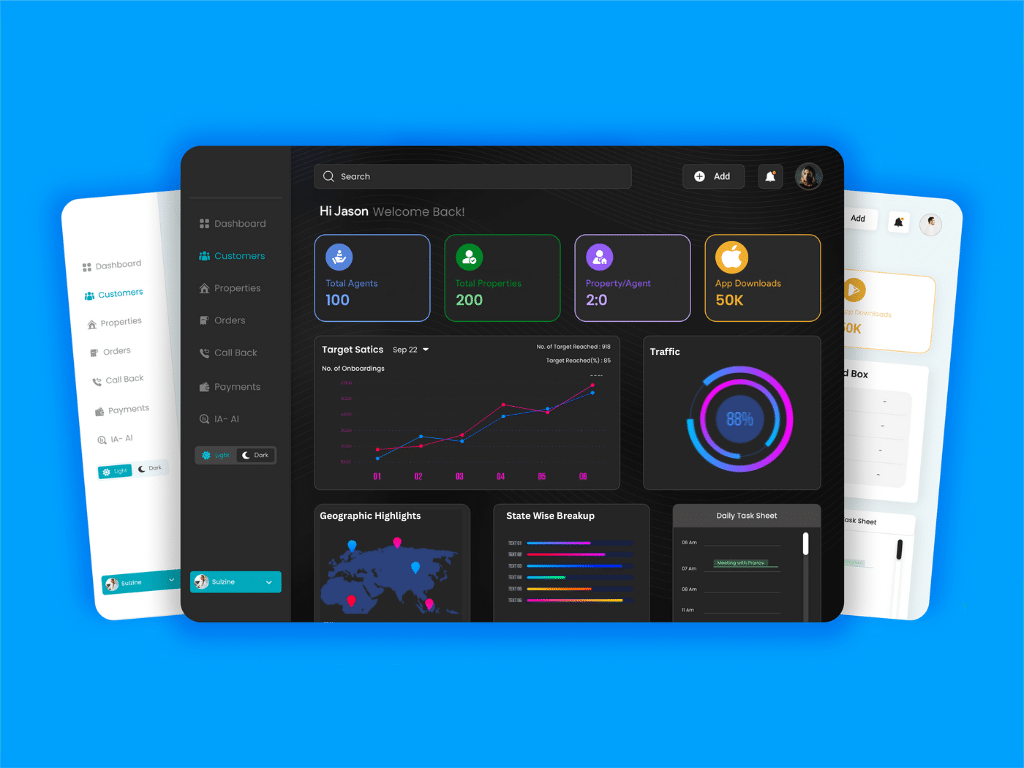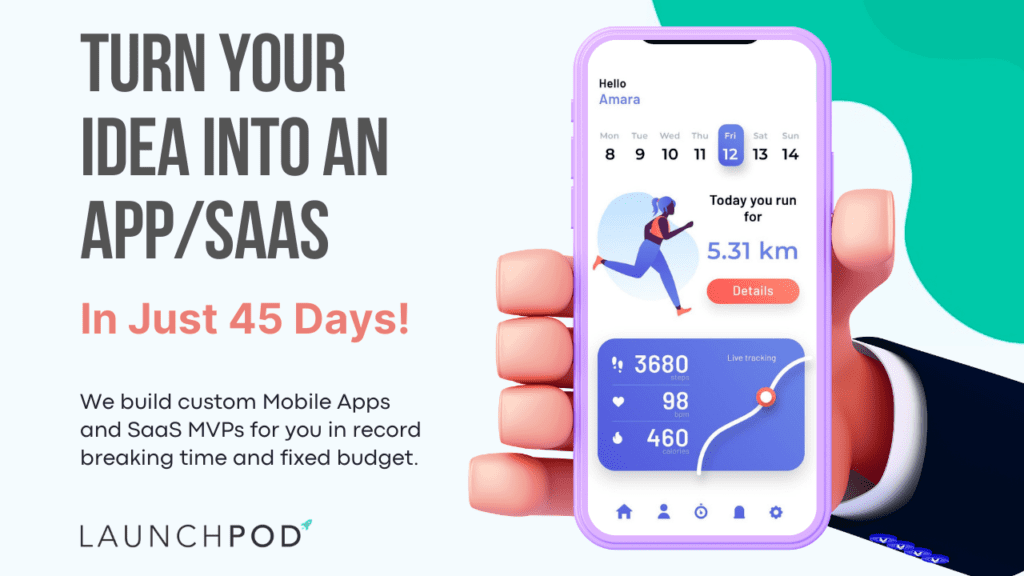
Introduction
Imagine stepping into the world of real estate with a powerful, market-ready MVP that takes care of all your business needs. This is exactly what our team at LaunchPod Labs achieved when we built a revolutionary real estate SaaS product for a non-technical founder. In this case study, we’ll take you through our exciting journey, sharing the development process, challenges, and lessons learned along the way. So buckle up, and let’s dive into the world of real estate SaaS!
The Challenge: A Non-Technical Founder’s Vision
Our client, a seasoned real estate entrepreneur with no technical background, approached us with an ambitious vision. They wanted a user-friendly, data-driven platform that catered to the needs of property managers, agents, and tenants. The challenge was clear: we needed to turn this vision into a tangible, market-ready real estate SaaS MVP within a tight deadline.

Stage 1: Laying the Foundation
The first step in our journey was to understand the unique needs of our client and their target audience. In order to achieve this, we embarked on a comprehensive research phase, delving deep into the world of real estate to identify the most pressing concerns and desires of property managers, agents, and tenants.
- Conducting Market Research: Our research began by analyzing the current real estate landscape, evaluating competitor offerings and identifying gaps in the market. This helped us gain a clear understanding of the opportunities available and the potential niches our client’s real estate SaaS product could fill.
- In-Depth Interviews: We conducted extensive interviews with property managers and agents, focusing on uncovering the pain points they experienced in their daily operations. These interviews provided invaluable insights into the challenges faced by our target audience, as well as their expectations for a solution that would streamline their workflow.
- Identifying Desired Features: Alongside identifying pain points, we also gathered information on the desired features and functionalities that would make our client’s SaaS product stand out. By understanding what was most important to the users, we could ensure that the product we developed would address their needs effectively.
- Creating User Personas: To help guide our development process, we created detailed user personas representing the various stakeholders who would interact with the platform. These personas helped our team visualize the end-users, enabling us to design a product that would cater to their specific needs and preferences.
- Developing a Product Roadmap: With a solid understanding of our target audience and their requirements, we crafted a comprehensive product roadmap outlining the core features and functionalities to be developed. This roadmap served as a strategic guide for our team, enabling us to prioritize tasks and allocate resources efficiently.
- Aligning with the Client’s Vision: Throughout the foundation-laying stage, we maintained close communication with our client, sharing our findings and seeking their input. This collaborative approach ensured that our research and product roadmap aligned with their vision, setting the stage for a successful development process.

By laying a strong foundation through in-depth research, user insights, and strategic planning, we were able to embark on the next stages of product development with a clear direction and a deep understanding of the needs of our client and their target audience. This meticulous approach to the initial stage of the project not only helped to inform our subsequent decisions but also paved the way for a more streamlined and effective development process.
Stage 2: Designing the User Experience
With a solid foundation built on valuable insights and a comprehensive understanding of our users, we moved on to the next stage of our journey – designing the user experience for the real estate SaaS MVP. Our goal was to create a user-centric platform that was not only functional but also visually appealing and intuitive to navigate.
- User Flow Mapping: We began by mapping out user flows, detailing the various paths users would take while interacting with the platform. This exercise helped us identify potential bottlenecks and ensure a seamless experience throughout the user journey.
- Wireframing: Our design team then started crafting wireframes for the platform. Wireframes are simple, low-fidelity representations of the user interface, which allowed us to experiment with layout and navigation quickly. This iterative process helped us identify the most effective and user-friendly design solutions.
- High-Fidelity Mockups: Once the wireframes were refined, we moved on to creating high-fidelity mockups. These detailed visual representations of the user interface incorporated colors, typography, and visual elements, bringing the platform to life and giving us a clearer vision of the final product.
- User Interface Design Principles: Throughout the design process, we adhered to fundamental user interface design principles, such as consistency, feedback, and simplicity. By focusing on these principles, we ensured that the platform’s design was not only visually appealing but also intuitive and easy to use.
- Interactive Prototyping: To further refine the design, we developed interactive prototypes of the platform. These prototypes allowed us and our client to experience the platform in action, giving us a chance to identify any usability issues and make necessary adjustments before moving on to the development stage.
- Client Collaboration and Feedback: Close collaboration with our client was crucial during the design stage. We shared wireframes, mockups, and prototypes with them, gathering their feedback and implementing necessary changes. This iterative process ensured that the design stayed aligned with the client’s vision and expectations.
- Design Handoff: Once the design was finalized, we prepared a design handoff package for our development team. This package included all the necessary assets, such as style guides, design specifications, and graphical elements, ensuring a smooth transition between the design and development stages.

By meticulously designing the user experience and collaborating closely with our client, we created a clean, intuitive, and visually appealing platform that addressed the needs of property managers, agents, and tenants. This user-centric approach laid the groundwork for a successful development process and set the stage for a real estate SaaS MVP that would resonate with our target audience.
Stage 3: Developing the MVP
With a well-designed user experience in hand, we entered the exciting stage of developing the minimum viable product (MVP). Our objective was to transform the design into a functional, scalable platform that would deliver a seamless experience to users while allowing for rapid development and integration with third-party tools.
- Choosing the Tech Stack: The first step in developing the real estate SaaS MVP was selecting the right technology stack. Our team carefully considered various options, taking into account factors such as scalability, performance, maintainability, and ease of integration with third-party services. Ultimately, we chose a robust and flexible tech stack that allowed for rapid development while ensuring long-term stability and growth potential.
- Setting Up the Development Environment: With the tech stack finalized, our development team set up the development environment, including version control systems, continuous integration and deployment pipelines, and project management tools. This streamlined setup ensured that our team could work efficiently and collaboratively throughout the development process.
- Agile Methodologies and Sprints: To ensure a steady pace of progress and to adapt quickly to changes and feedback, we adopted agile methodologies and organized our work into sprints. This approach allowed us to break down the development process into manageable tasks, prioritize features, and maintain a clear focus on delivering a market-ready MVP.
- Feature Development and Integration: Our development team worked diligently to build the core features and functionalities outlined in the product roadmap. We also integrated the platform with various third-party tools and services, ensuring a seamless user experience and enhancing the platform’s overall capabilities.
- Quality Assurance: To guarantee a high-quality product, our development team closely collaborated with the quality assurance (QA) team, conducting regular code reviews and adhering to best practices for software development. This attention to quality helped us minimize bugs and maintain a high level of reliability throughout the development process.
- Continuous Client Feedback: Just as in the design stage, we maintained open lines of communication with our client during the development phase. By sharing progress updates and seeking their feedback, we ensured that the MVP stayed aligned with the client’s vision and expectations. This ongoing collaboration allowed us to make necessary adjustments and iterate on the product in real-time.
- Documentation: To facilitate future maintenance and enhancements, our development team created comprehensive documentation of the platform’s architecture, features, and codebase. This documentation served as a valuable resource for both our team and the client, ensuring a smooth handover and a clear understanding of the platform’s inner workings.
By employing agile methodologies, focusing on quality, and maintaining close collaboration with our client, we successfully developed a functional, scalable real estate SaaS MVP that effectively addressed the needs of property managers, agents, and tenants. This stage marked a significant milestone in our journey, bringing us one step closer to launching a market-ready real estate SaaS product.
Related read: SaaS Ideas 2023: Latest Trends and Predictions
Stage 4: Testing, Testing, and More Testing
As we reached the testing stage of our journey, our primary focus was to ensure that the real estate SaaS MVP we had developed was not only feature-rich but also stable, reliable, and scalable. We conducted a series of thorough tests, leaving no stone unturned in our quest to deliver a flawless real estate SaaS product.
- Unit Testing: Our QA team started with unit testing, which involves testing individual components or functions of the platform in isolation. This granular approach allowed us to identify and fix issues at the most basic level, ensuring that each part of the system worked as intended.
- Integration Testing: Once the individual components were thoroughly tested, we moved on to integration testing. This process involved testing how different parts of the platform interacted with one another, ensuring seamless communication and functionality across the system.
- Performance Testing: To guarantee that the platform could handle the demands of its users, we conducted performance tests. These tests evaluated the platform’s response times, throughput, and resource usage under various conditions, allowing us to optimize the system for peak performance.
- Load and Stress Testing: As a scalable solution, the platform needed to handle a growing user base and increased load gracefully. We performed load and stress tests to evaluate the platform’s performance under heavy traffic and extreme conditions, making necessary adjustments to ensure stability and reliability during peak usage.
- Security Testing: The security of our client’s data and user information was of utmost importance. Our QA team conducted security tests to identify potential vulnerabilities, ensuring the platform was compliant with industry standards and best practices for data protection.
- Usability Testing: To ensure a smooth and enjoyable user experience, we conducted usability tests with real users, observing their interactions with the platform and gathering feedback. This process allowed us to identify areas for improvement and make the necessary adjustments to enhance usability and user satisfaction.
- Manual and Automated Testing: Throughout the testing process, our QA team employed a combination of manual and automated testing methods. Manual testing involved human testers exploring the platform and identifying issues, while automated testing utilized scripts and tools to quickly identify and report bugs and glitches.
- Bug Fixing and Iteration: As issues were uncovered during the testing process, our development team worked closely with the QA team to address and fix them promptly. This collaborative approach ensured that the platform’s quality remained high and that potential problems were resolved before launch.
By rigorously testing the real estate SaaS platform and addressing any issues that arose, we ensured that the MVP was stable, secure, and scalable. This thorough testing stage was crucial in guaranteeing a smooth user experience and instilling confidence in our client as they prepared to launch their market-ready product.
Related read: Building Your Micro SaaS MVP: A Step-by-Step Guide
Stage 5: Deployment and Go-Live
As the development and testing stages came to a successful conclusion, we reached the exciting moment of deploying the real estate SaaS product and making it available to the public. This stage involved setting up a robust, scalable cloud infrastructure and implementing vital security measures, ensuring a smooth launch and reliable performance for the platform’s users.
- Cloud Infrastructure Setup: To support the platform’s scalability and performance requirements, we chose a cloud infrastructure solution that would allow the platform to handle traffic spikes and maintain optimal performance. Our team carefully selected the appropriate cloud services and resources, ensuring cost-effective and efficient infrastructure management.
- Infrastructure Monitoring and Management: With the cloud infrastructure in place, we set up monitoring and management tools to track the platform’s performance, resource usage, and potential issues. These tools provided us with real-time insights, enabling us to proactively address any problems and optimize the platform for maximum performance.
- Security Implementation: Security is a top priority for any SaaS product, and our platform was no exception. We implemented robust security measures, such as encryption, secure access controls, and intrusion detection systems, to protect the platform and user data. These measures ensured that the platform remained compliant with industry standards and best practices for data protection.
- Backup and Disaster Recovery: To guarantee the platform’s reliability and minimize downtime, we established a backup and disaster recovery strategy. This strategy included regular data backups, redundancy measures, and a well-defined recovery plan, ensuring that the platform could quickly recover from any potential data loss or system failure.
- Staging and Production Environments: To facilitate a seamless deployment process, we set up separate staging and production environments for the platform. The staging environment allowed us to test the final product in a production-like setting before launch, while the production environment hosted the live platform accessible to users.
- Deployment Automation: Our development team implemented deployment automation processes, streamlining the transition from staging to production environments. This automation ensured a seamless and error-free deployment, reducing the risk of downtime during the go-live process.
- Go-Live and Launch: With the cloud infrastructure, security measures, and deployment processes in place, we were ready to launch the real estate SaaS platform. We coordinated with our client to determine the best time for the go-live event, ensuring that all stakeholders were prepared and ready for the big moment.
- Post-Launch Support: After the successful launch, our team continued to provide post-launch support, monitoring the platform’s performance and addressing any issues that arose. This ongoing support guaranteed a smooth and reliable experience for the platform’s users, while also allowing us to gather valuable insights for future improvements.
By meticulously preparing for the deployment and go-live stage, we ensured a successful launch of the real estate SaaS product. The platform’s robust cloud infrastructure, security measures, and well-executed deployment processes provided users with a reliable and high-performing solution, marking the culmination of our journey in building a real estate SaaS MVP for our client.
Challenges and How We Overcame Them
- Tight Deadlines: Our client needed a market-ready MVP within a strict timeframe. To meet this challenge, we adopted agile methodologies and worked closely with the client, ensuring regular feedback and fast iteration cycles.
- Complex Integrations: The platform needed seamless integration with various third-party tools and services. We carefully selected tools and APIs that aligned with the product’s goals and devised an integration strategy that ensured a smooth user experience.
- Customization: Our client wanted a product that catered to different types of users, requiring a high level of customization. We designed a modular architecture, allowing users to tailor the platform to their specific needs.
- Scalability and Performance: The product needed to handle a growing user base and deliver a fast, reliable experience. We chose a scalable tech stack and optimized the platform’s performance through regular testing and monitoring.
Learnings and Key Takeaways
- User-Centric Approach: Understanding the needs of the target audience was crucial in shaping the product’s design and functionality. Involving users in the development process ensured we built a solution that resonated with the market.
- Agile Development: Adopting agile methodologies allowed us to stay flexible and responsive to the client’s needs, ensuring a successful product launch within the given deadline.
- Communication: Maintaining open lines of communication between our team and the client was critical in keeping the project on track. Regular feedback and collaboration helped us refine the product and make better-informed decisions.
- Embrace Challenges: Overcoming the various obstacles we faced throughout the project taught us valuable lessons in problem-solving, adaptability, and resilience. These experiences have made us better equipped to handle future challenges.
- Continuous Improvement: Even after the product went live, we remained committed to refining and optimizing the platform based on user feedback and performance metrics. This dedication to continuous improvement ensures the platform stays ahead of the competition and remains relevant to its users.

Conclusion
Building a real estate SaaS product for a non-technical founder was an exciting journey full of challenges, learnings, and growth. Through close collaboration with our client, adopting agile methodologies, and focusing on user-centric design, we were able to deliver a market-ready MVP that exceeded expectations. This case study is a testament to the power of creativity, teamwork, and perseverance in turning a founder’s vision into reality.
We hope this in-depth look into our development process inspires other entrepreneurs and product builders to take on the challenge of creating innovative solutions that make a difference in their industries. At LaunchPod Labs, we’re always ready to embark on a new journey and bring your ideas to life. So, are you ready to take the plunge and build your market-ready MVP? Reach out to us and let’s start turning your vision into a reality!